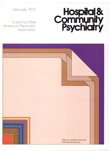Hospitals in the 1980s: Service, Training, and Research
Abstract
Several factors press for change in the psychiatric hospital of the 1980s, including knowledge obtained from recent controlled studies of outcome of different approaches and length of hospital stay, changes in the social-political-economic climate, and new methods of organizing the delivery of services. In the proposed model of inpatient treatment, the primary use of hospitalization will be for brief treatment (three to 21 days). For a very small subgroup, longer hospitalization may be needed. The hospital will also be used for triage and disposition of persons with a broad range of problems, which will rarely take more than three days. Complementary changes will be required in training and research; a promising training model may be continuous care teams by which trainees can manage chronic, multiproblem patients through different levels of care within and outside the hospital. Research must move to the out-of-hospital settings if the new patterns of care are to be understood and improved.
Access content
To read the fulltext, please use one of the options below to sign in or purchase access.- Personal login
- Institutional Login
- Sign in via OpenAthens
- Register for access
-
Please login/register if you wish to pair your device and check access availability.
Not a subscriber?
PsychiatryOnline subscription options offer access to the DSM-5 library, books, journals, CME, and patient resources. This all-in-one virtual library provides psychiatrists and mental health professionals with key resources for diagnosis, treatment, research, and professional development.
Need more help? PsychiatryOnline Customer Service may be reached by emailing [email protected] or by calling 800-368-5777 (in the U.S.) or 703-907-7322 (outside the U.S.).



